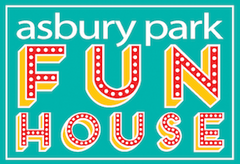New Icons, Asbury Park
There are so many things about Asbury Park to love, especially the history of some of the more iconic sights throughout the town. As a way to pay homage to the history of our beloved shore retreat, we wanted to come up with a few memorable designs to include more of the unique culture and history of Asbury Park for both locals and visitors. This blog is dedicated to all who love to seek out those not-so-obvious icons that make this town one of the most special places along the New Jersey shore.
Summer of 2013

After the successful launch of our Asbury Park t-shirts, Gene and I wanted to expand the selection of designs at Fun House. The challenge was to create new designs that would stand up to Tillie and Greetings From Asbury. Our first requirement was that each design had to be inspired by something already part of the City, something recognizable but also overlooked. The second requirement was to use local artists to interpret those designs, the artists’ personal style a unique hand. We called this category “New Icons.”
Two Fish

We found inspiration for the first New Icon right on our doorstep. Literally. The Fun House beach store is located inside the Grand Arcade, the north-to-south passage of the boardwalk through Convention Hall. Across from Fun House, high on the east wall of the Grand Arcade, are a pair of glazed terracotta dolphins. Ceramic tiles in the baroque Beaux-Arts style, the giant scallop shell flanked by a pair of dolphins was exactly what we were looking for, our very first New Icon.
Convention Hall
Convention Hall dominates the Asbury Park beachfront. This grand dame of the Jersey Shore, Convention Hall has hosted almost a century of concerts, conventions, rallies, bazaars, and flea markets, and has been home to decades of shops, bars, and restaurants.
Construction of Convention Hall, however, was not straightforward or inevitable. In 1917, Asbury Park Mayor Hetrick hired architectural giants McKim, Mead, and White, known for the original Penn Station and the New York Public Library, to build a convention center on a site north of Atlantic Park, now Bradley Park. Asbury Park’s founder, James Bradley, refused to sell the lot to the City, stubborn to uphold his vision of the City as a contemplative, restorative resort. Instead, Bradley sold to Arthur C. Steinbach, who would build the Berkeley-Carteret Hotel. Locals will recognize the name, from his Steinbach’s, “the world’s largest resort department store,” the flagship store covering an entire city block in downtown Asbury Park.
In 1925, with the opening of Madison Square Garden in New York City, the nation went convention crazy with cities like nearby Atlantic City erecting grand venues to host large scale events to attract business and visitors. City leaders saw a convention center as a means to establish Asbury Park as a year-round destination. In 1927, the Fifth Avenue Arcade on the Asbury Park Boardwalk burned down (it is said “mysteriously”.) With an ideal site for a convention center, the mayor hired the architecture firm Warren and Wetmore, Whitney Warren having worked on the Berkeley-Carteret Hotel, the firm renowned for their design of the reconstruction of Grand Central Station In New York City.
Convention Hall was envisioned as a grand convention complex, the Paramount Theater anchoring the site at Bradley Park and Convention Hall extending across the boardwalk and beach right to the ocean. A companion Casino Complex with a Carousel House was added at the south end of the boardwalk. Built in the baroque Beaux-Arts style drawing on inspiration from French and Italian architecture, Warren and Wetmore used nautical, musical, and theatrical elements throughout the project. Definitely search these out because they are a surprisingly beautiful site. Construction on Convention Hall finally began in 1928 and was completed in 1930, just as the country was sinking into Depression.
Porkchop

Having decided on Two Fish as the New Icon, we approached local artist Porkchop to work up sketches, adding “Asbury Park” into the design. Porkchop, with murals throughout Asbury Park, brought an edge, a tattoo-like line with a classic composition that was beyond our expectations. Gene and I were thrilled with the design.
Initial sales of Two Fish were slow, Tillie and Greetings a hard habit to break for some customers. We stood behind the design and printed Two Fish tanks, sweatshirts, and onesies. We made Two Fish embroidered patches, enamel pins, and mugs, Two Fish tote bags, and beach towels. By the Summer ’22 we completely sold out of Two Fish tote bags and beach towels. We had created a New Icon! We credit locals with the initial popularity of the design, which is now a Fun House mainstay, sometimes outselling Tillie.
And I have to admit, it’s hard not to be proud when I see a Two Fish sticker on the back of a car heading north on the New Jersey Turnpike.
Collaboration
The Fun House x Porkchop collaboration on Two Fish and its success enabled us to create a template for future designs and artists. As with all of our Fun House x Artist collaborations, Porkchop receives 10% of sales of his design. In a later blog we will talk about Fun House’s leap forward to collaborate with artists from the Wooden Walls Project, Asbury Park’s mural non-profit, but we’ll save that for another post.
Thank you for reading all the way to the end. I am indebted to Helen Pike and her Asbury Park’s Glory Days as an unequaled source for everything Asbury Park, of those places we know and love, and those we had no clue existed. Helen is a well of stories of our 1.5 square miles of heaven. Check out her remarkable books, www.HelenPike.com


Leave a comment